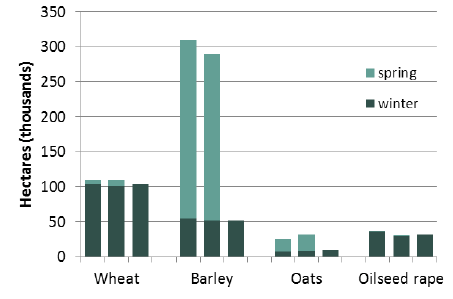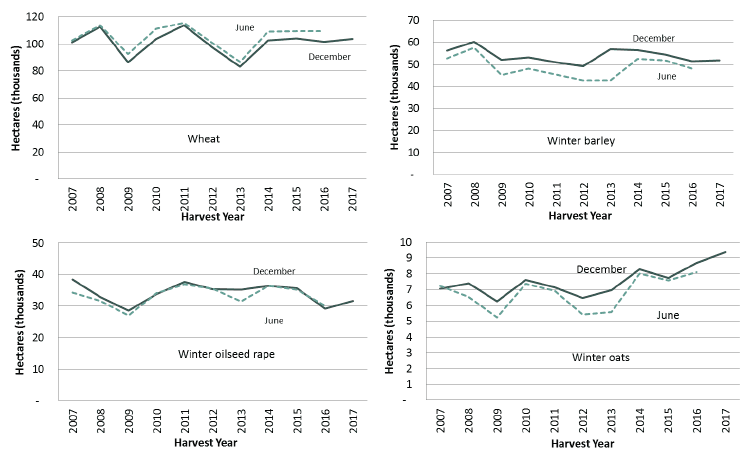Scottish agricultural survey: December 2016
Annual agricultural survey based on data from larger agricultural holdings together with estimates for smaller farms.
This document is part of a collection
3. Winter crops
Year-on-year comparisons between 2015 and 2016 December Survey results show:
- An increase in the area of winter crops, of 5,800 hectares (3.1 per cent) to 196,600 hectares. The figure is 0.5 per cent higher than the ten-year average of 195,700 hectares.
- An increase in winter wheat of 2,300 hectares (2.3 per cent) to 103,900 hectares. The figure is 3.0 per cent higher than the ten-year average of 100,900 hectares.
- An increase in winter barley of 400 hectares (0.8 per cent) to 51,800 hectares. The figure is 3.4 per cent lower than the ten-year average of 53,600 hectares.
- An increase in winter oats of 700 hectares (8.1 per cent) to 9,400 hectares. The figure is 24 per cent higher than the ten-year average of 7,600 hectares.
- An increase in winter oilseed rape of 2,400 hectares (8.0 per cent) to 31,600 hectares. The figure is 6.0 per cent lower than the ten-year average of 33,600 hectares.
→ Insight
In 2015, changes were made to the EU Common Agricultural Policy ( CAP) support schemes. In particular, there was a requirement for crop diversification. This may have impacted upon winter planting choices, particularly the continued increase in oats.
3.1 Winter or Spring?
Chart 1 illustrates winter and spring crop areas from the 2014/15 and 2015/16 growing years, together with the latest December 2016 data.
Spring varieties are prominent for barley and oats, with winter varieties prominent for wheat and oilseed rape.
Chart 1: Winter and Spring Crops

For each crop the chart shows the values at June 2015, June 2016, and then December 2016. The spring-planting values for the latest year are not yet known
The December Survey only provides the first indication of trends of winter sown crops. More comprehensive results are produced from the June Census in the following year.
Chart 2 shows trends in winter crops reported in the December Survey and the following June Census over the past ten years. Results are presented against the year of harvest, so for example the 2015 December Survey results are presented against June Census results from 2016.
Chart 2: Winter crops [1] , December Survey and June Census by year of harvest

→ Insight
Final wheat figures are generally slightly higher than December figures due to small areas of spring wheat, or winter wheat sown after the start of December. Among other crops, the June figures for winter crops are often lower than those reported in December. This is likely to be due to poor weather conditions resulting in failed winter crops which are then re-sown as spring crops.
Contact
Email: agric.stats@gov.scot
There is a problem
Thanks for your feedback